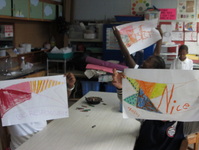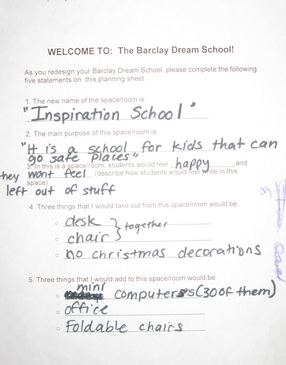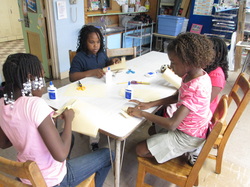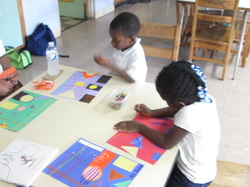
GD K-1 My Many ColorsSuccesses: What I felt to be most successful in this unit, was the student engagement in the process of making art. It seems that these students rarely have the opportunity to paint and make patterns on a large scale. I also think the multiple mediums allowed for very different artistic experiences within the same project. There was no prescribed outcome for this project which allowed students to make their own choices about what colors to chose and what kinds of pattern to make. What was reinforced to me throughout this unit was that student choice, in art making, can lead to higher investment in the work, which then can result in higher quality work.
Challenges: Some students had a difficult time cutting out their figures. They are still young at this age and haven’t fully developed their fine motor skills. They needed quite a bit of help, especially if the poses they took on for their silhouettes were more dynamic. The final challenge was the background. For this part I let students do whatever they wanted. It acted as an extension for those who were done early. I’d like to figure out a more directed idea of what kids could do for their backgounds.

GD 2-3 Splish Splash BannersSuccesses: I think that the idea behind this unit is good. Creating banners to declare and celebrate respect in the classroom. I also found that the streamers were a fun addition at the conclusion of the banner-making.
Challenges: This has been a challenging class from the start because it’s a very large group and there have been so many contrasting personalities. Classroom management has become a large focus within each class. I think that there was a lot less investment from the students in doing this project. One reason why this art exploration was not as successful is because of the lack of the personal meaning. Recognizing this, I created my next lesson to have that personal tie-in. The 2-3rd Graders are now becoming superheroes, creating a symbolic mask showing their super-strengths.

GD 4-5 Dream School Project
Successes: In terms of student interest and investment, this has been the most successful art exploration. The project is collaborative. Students have really gotten into this idea of team-work. Last week Rashwana who was acting as a leader for the team told her group at the end of class, “I’m really proud of our work”. This was after she mediated a heated discussion about who was going to use the glue saying, “We just need to work together, disagreement is going to set us back.” Joi in another group told me, “What I like about this art program is that you listen to the kids’ ideas.” Both of these comments were very meaningful to me as a teacher, because I think collaborative art making is really good for kids to learn how to probem-solve and the skills developed by this experience are built upon and used throughout life. Joi's comment was important because student choice is so important in education and especially in art making. Choice allows for creativity.
Classroom management has prevented me to do collaborative projects with my other classes. I want to find a way that students can still work together despite this. That’s for me to think more about.
Challenges: At the beginning it was hard for the class to focus on my demonstration of making paper shapes. When the kids are working, they are focused and energetic about their art, it’s when they are waiting or watching that they become disrespectful. I’m learning that demonstrations need to be short and to the point. But I’ve also had experiences where demonstrations are too short and then the quality of student work suffers because a student didn’t know what to do.
*to see the full unit sequence, please visit the Lesson Plan page.
The moments of my teaching that really move me are when students feel compelled to express something that is deeply meaningful to them.
Art enables children to communicate their emotions and personal stories. There are layers of meaning to be interpreted within a child's work of art. Art enables students to learn about each other, and teachers to understand student needs. This is a significant reason for why art should be advocated within schools.
This story is about a student of mine. His name, for now, is Noah. Somethings that I have observed about Noah is that he likes to be by himself and work on his art alone. Often in class when I look over, I see him distracted by materials around the classroom and talking to himself. The group that Noah is in, my class of forth and fifth graders, are currently working on redesigning and building the
Barclay Dream School. This project is collaborative, and students have divided themselves into groups. Noah works alone, and seems content to do so. In this project the kids in my class were encouraged to be imaginative and open to the possibilities of what their new school environment could be like. As a part of the planning process, each team filled out a
Dream School Think Sheet to document the new purpose of the space and how students would feel when they were in it. This encouraged the students to think beyond what the school would look like to what feelings the space would evoke. At the conclusion of class, we shared our new, innovative ideas about how to redesign our spaces.

When Noah presented his Dream School idea, he told the class that his school would be called the "Inspiration School". Kids would be able to feel safe and they wouldn't feel left out he told us. The classrooms would have computers for everyone and the rooms would be clean and colorful. Noah would be the principle to ensure things were carried l effectively.
When Noah presented his Dream School idea, he told the class that his school would be called the "Inspiration School". Kids would be able to feel safe and they wouldn't feel left out. The classrooms would have computers for everyone and the rooms would be clean and colorful. Noah would be the principle to ensure things were carried out effectively.

The new name of the space/room is 'Inspiration School'. The main purpose of the space/room is 'it is a school for kids that can go safe places' In this space/room students would feel 'happy' and 'they won't feel left out of stuff' Three things that I would take out from this space/room would be 'desk-chair', no Christmas decorations. Three things that I would add to this space/room would be 'mini computers (30 of them), office, foldable chairs.'
In the Dream School Project Noah identified an issue that was important to him and addressed it in the new design of his school. If we as teachers allow room in our projects and lessons for our students to express their individual ideas, I think that we can give students the opportunity to be empowered by their thinking and creativity, while also allowing for an outlet to express personal needs. Now I am aware that Noah feels left out and sometimes unsafe, and I can do my best to address to accommodate him.

Last week I spoke of creating an environment for my classes. I've noticed that there is a difference between creating and environment and maintaining one. This week in one of my classes there was a severe lack of community and respect. I've learned a lot from this past week.
Developing the culture of my classroom is what is most important to me right now in my teaching. For me, it has been relatively simple to write my teaching philosophy based on my own personal experiences and core values. I believe that children should learn and grow in a safe and nurturing environment. They should be guided through experiences that enable the development of their art vocabulary and skills. With these tools children will have what they need to express and discuss their ideas. I further think that students should take an active role in their own educational experience by asking questions, investigating ideas, and arriving at possible outcomes.
The challenge that I am facing, as a new teacher working in an urban environment, is defining the culture and climate of my art classroom. I need to figure out how my teaching philosophy melds with who my students are, what they know, and what they need. On Wednesday I had a rough class. There were many contributers to the disorganized chaotic outcome. In the first half of class I had to shut down the art project because I was concerned for student safety. I didn't have a back up plan ready to go, and I was flustered by the arguments and frustrations of my students. A teacher from across the hall came in and loudly projected her voice at my class telling them to be quiet. It was embarrassing for me to feel out of control. I have now realized, in retrospect, that I had not yet spent time building a community. The children don't know me, and I really don't know them either.
Teaching is a reflective practice: doing, observing, reflecting, refining, and then doing again. Reflective practices allows for growth. This week there was a large lack of community in my class and next week I am going back to spend time with my class re-identifying expectations, and exploring how we want to feel in our art classroom . Kids will create two drawings of themselves, one illustrating what makes them upset, the other showing what makes them feel safe and happy. We will share these as a group and discuss the ways that we individually and collectively can make each other feel good about making artwork.
I know that my teaching philosophy will morph over time and with new experiences, but I will strive to first develop and then maintain that safe and respectful environment.
I have so many great art projects planned that centralize around the themes of dreams, self, school and community. But I know that the art making will only be productive and meaningful if students can feel safe and free to express themselves.







 RSS Feed
RSS Feed